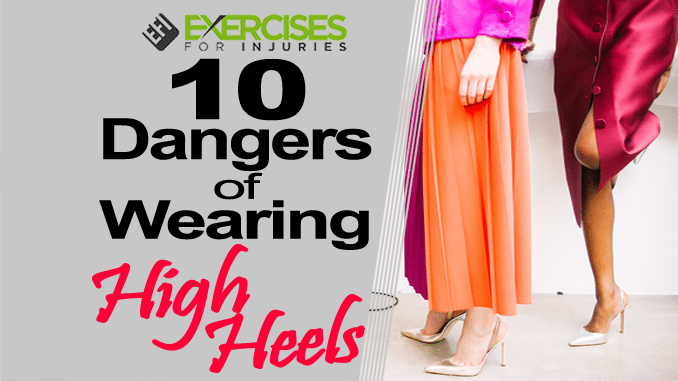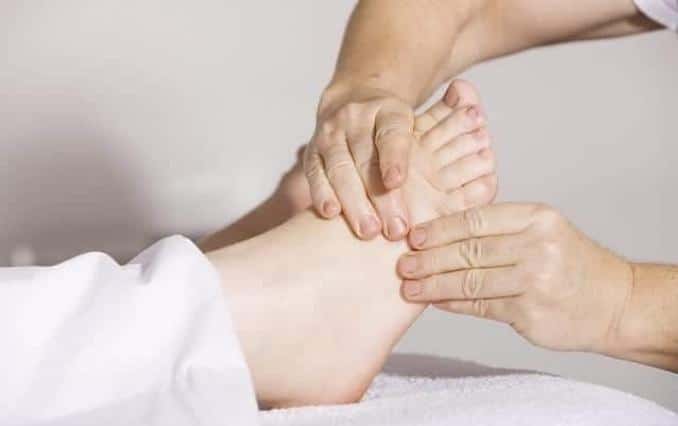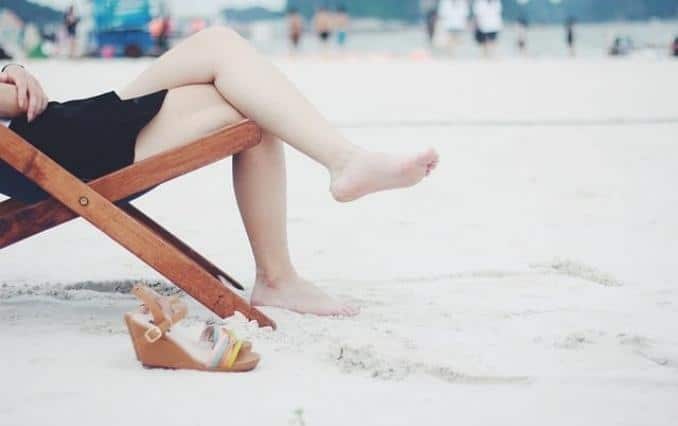
Yes, those shoes are adorable! They make you look taller and slimmer, and they really dress up that outfit, don’t they? It just isn’t the same without those killer high heels!
Of course, after a couple of hours of wearing them, “killer” probably describes your heels in more ways than one. You can’t wait to get them off! Once they’re safely back in your closet the only thing you want is a long, slow foot rub.
Unfortunately, after years of wearing heels, you may need more than a massage to make things right again. Podiatrists agree that your heels, toes, joints, tendons, ankles, calves, knees, hips. And, even spine suffer when you force your feet into the unnatural position of standing in heels. Over time, you can suffer a number of serious injuries that affect your ability to walk and stay active.
If you want to keep your feet and body healthy, it’s best to avoid high heels as much as possible. Below, we explain why and, if you find you need to wear them sometimes, we have suggestions for things you can do to make them less damaging.
10 Ways High Heels Damage Your Feet and Body
According to a 2014 survey by the American Podiatric Medical Association, heels are the most common cause of foot pain among women. The problem is they force the feet, legs, and body into an unnatural position.
First, they restrict the foot’s movement, particularly in the toes, and then they shift your weight forward onto the ball of your foot. The higher the heel, the more weight is shifted forward. Meanwhile, your knees and hips push forward too and the back has to extend backward to provide a counterbalance. The result is a body that is misaligned. The longer you wear the heels, the more the body has to stay in this position, which eventually can cause pain and injury.
According to researchers in a 2012 study of long-term high-heel wearers. Walking in high heels increases muscle strains and compromised muscle efficiency and also increases the risk of strain injuries. Here are 10 of the most common conditions that may be caused or worsened by wearing high heels.
1. Corns and Calluses
Dangers of Wearing High Heels: These are hardened areas of skin that develop because of pressure and/or friction. If your shoes regularly rub against any area of the foot, the skin will try to protect itself by building up a hardened area that can better withstand the rubbing.
The two conditions are similar, but there are some differences. Calluses may develop over a small or large area and may vary in shape. Usually, they are not attractive, but they are not painful. Corns, on the other hand, usually have a hard center and may become inflamed. That means they’re likely to hurt when pressed.
2. Bunions
Dangers of Wearing High Heels: These are bony bumps that form on the outside of the big toe, right in the joint between the foot and the toe. Wearing heels can bring on bunions, particularly if the heels have a pointed-toe box. The shoe pushes the big toe into the toe next to it, forcing the joint to enlarge and stick out. This area becomes the bunion and can get red and sore when your shoes rub against it.
High heels can cause bunions, or may just make them worse. As the area gets bigger, it can be harder to find shoes that fit.
3. Hammertoe
Dangers of Wearing High Heels: This condition is most often the result of wearing high heels or other shoes with poor arch support. It’s a deformity of the second, third or fourth toe that causes the toe to bend downward abnormally right at the middle joint. Over time, the joint can stiffen and even become fixed in the downward position.
The deformity comes about because of an imbalance in the tendons, ligaments, and muscles in the toes. Wearing heels or tight shoes forces the toes into a flexed position, and eventually. They are not able to straighten out again. Hammertoes are typically painful and may develop corns or calluses on the top of the middle joint. If caught early enough, they can be treated.
4. Morton’s Neuroma
Dangers of Wearing High Heels: If you’re feeling pain in the ball of your foot, especially between the third and fourth toes, you may be developing this issue. Also called “Morton nerve entrapment,”. It is a thickening of the nerve leading to the area between the toes and can feel sharply painful. Other symptoms include a burning feeling in the ball of the foot or even numbness.
The Mayo Clinic notes that high-heeled shoes have been linked to Morton’s neuroma and that switching to more comfortable shoes with wider toe boxes can help relieve pain. Heels tend to squeeze and irritate the nerve, trapping it against the ligament. Over time, the pressure causes irritation and fibrosis (or thickening) of the nerve, which further compresses the nerve cells and causes more pain.
5. Plantar Fasciitis
Dangers of Wearing High Heels: This is an inflammation of the plantar fascia, which is the band of tissue that connects your heel bone to your toes. Symptoms include stabbing pain in the heel that is usually worse first thing in the morning. The pain often lessens as you go about your day. Long periods of sitting or standing can make the symptoms worse again.
There are many causes of plantar fasciitis, including age (it’s more common after the age of 40), being flat-footed or having a high arch, being overweight or obese, being on your feet all day, or certain types of high-impact exercise like long-distance running, jumping or ballet dancing.
There is also a link between wearing heels and suffering from plantar fasciitis. Heels force the arch of the foot into an unnatural position, which affects your gait and puts a strain on the plantar fascia, causing tearing and inflammation.
6. Heel Spurs
Heel spurs can be related to plantar fasciitis, especially if you wait too long before making adjustments to ease the inflammation of the plantar fascia. As that inflammation continues, it can eventually cause the formation of a heel spur at the bottom of the heel, toward the back of the Achilles tendon.
A heel spur is a small, sharp, bony spur on the heel bone. It develops over time as that bone is exposed to stress. The spur can extend down as much as half an inch and can cause pain during walking or other activity. Joggers and dancers who regularly impact the heel and stress the plantar fascia can be at risk for heel spurs as can those who are overweight or who wear heels regularly.
7. Sprained Ankle
Dangers of Wearing High Heels: When you wear high heels, you create instability in the ankle. The ankle typically moves up and down when you walk but, when you wear heels, your feet are restricted. This means that the ligaments that support the ankles are locked in a permanent downward stretch while the Achilles tendon is pinched short. The ankle can no longer move as it naturally would.
In time, the tendons are strained, which can cause ankle pain and eventually weaken the ankles. This puts you at a higher risk for a sprained ankle or other ankle injuries as the supportive tissues become less able to withstand the stress.
8. Stress Fractures
Stress fractures are broken in the bone that results from recurring stress or force is placed on that bone. Unlike a traumatic fracture that occurs because of excessive force placed on the bone at one time, a stress fracture occurs because of a moderate amount of force placed on the bone again and again until it eventually responds. It usually breaks but doesn’t shift position.
There are many causes of stress fractures, including high-impact sports, but wearing high heels can cause them too because they put a lot of pressure on the ball of the foot and the toes. Any bone in the foot may be affected, including the metatarsals (which connect the middle of the foot to the toes), ankle bones, and heel bone. Fractures usually feel pain with activity, and ease up with rest.
9. Knee Pain & Osteoarthritis
Dangers of Wearing High Heels: Heels change the way you walk. Because they force the body into a strange alignment, they put stress not only on your feet and ankles but your knees too. In a 2014 study, researchers studied women when they were wearing various types of shoes, from flat athletic shoes to high-heeled shoes. They found that at regular walking speed, the knee flexion angle increased with increasing heel height.
“Many of the changes observed with the increasing heel height and weight were similar to those seen with aging and OA [osteoarthritis] progression,” the researchers concluded. “This suggests that high heel use, especially in combination with the additional weight, may contribute to OA risk in women.”
Study author Constance Chu, M.D., professor of orthopedic surgery at Stanford University, added that heels make it harder for the knee to straighten when it needs to. “This then puts more pressure for longer periods on the kneecap and the inside of the knee, making it more likely to wear away faster.”
10. Back & Hip Pain
High heels shift the position of the body, causing the muscles around the hips and back to have to compensate to keep you upright. The Spine Health Institute notes that when you’re wearing heels, the normal, S-curve of the back flattens out, which can lead to muscle overuse and pain. The institute also links regular high-heel use with sciatica, which causes shooting pains in the back and down the leg.
Spend too much time in heels and you could also suffer from spinal abnormalities, including spondylolisthesis (where one vertebra slips over another) and foraminal stenosis, which is a squeezing of the nerves in the spine.
The shift in gait and body position can also put a strain on the hips, causing pain and muscle cramping and, in some cases, potentially exacerbating or increasing the risk of hip arthritis.
How to Lessen the Damage High Heels Create
If you want to protect your feet, ankles, joints, and back, it’s best to limit the time you spend in heels — period. Most of the time, choose supportive, quality shoes that are good for your feet and body. If you need to wear heels from time to time, take the following steps to help limit the damage they can create:
- Wear them for as short a period as possible; take other comfortable shoes with you so you can change in and out of them
- Go for heels that are 2 inches high or less; the higher the heel, the more weight is shifted forward onto the ball of the foot
- Choose quality heels that fit well; cheap ones that leave a big gap behind your heel or that have no cushioning or support can cause pain and damage more quickly
- Use a full-shoe insert that helps cushion the foot or invest in silicone metatarsal pads to support the ball of your foot
- Choose a thicker heel — think wedges and platforms over pointy stilettos
- Wear open-toed shoes when possible as they can help give your toes more room to move and are less likely to cause or worsen corns and calluses
- Look at the “slope” of the shoe — the angle from the heel to the toe — as those with a more gradual slope is easier on the arch while those that plunge straight downward are more harmful
- Stretch your legs regularly; try yoga or another similar exercise routine to counteract the tightness created by heels
Have you developed plantar fasciitis? You are not alone! Make sure to check out Plantar Fasciitis Relief in 7 Days, here!



